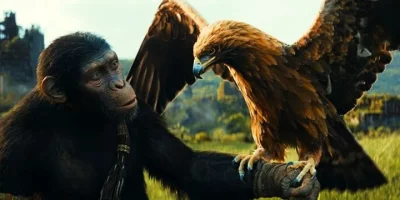
Wētā’s Phillip Leonhardt on The Evolution of Apes and VFX
Film
Since the early days of black-and-white celluloid and silent movie houses, perhaps no other aspect of filmmaking has been more focused on innovation than the art of special effects. Phillip Leonhardt, a Visual Effects Supervisor for the renowned Wētā FX, has been a part of this process for decades. Kingdom of the Planet of the Apes features Leonhardt’s most recent work and serves as a powerful example of the evolution not only of the title characters, but of visual effects magic and the artists who create it.
“We’re constantly trying to look for new ways of doing things,” says Leonhardt, who moved to New Zealand to work for at Wētā in 2005, on Peter Jackson’s epic version of King Kong. Since then he has worked on films such as Avengers: Endgame, Alita: Battle Angel and Maze Runner: The Death Cure. “Milestones have been achieved and envelopes have been pushed. Tech never stands still,” Leonhardt says. While a lot of effects work goes into the Planet of the Apes franchise, it’s bringing the title characters to life that really keeps the Wētā artists on their toes. “There’s so many aspects to it,” Leonhardt says. “We’re designing, we are modeling and we’re shading and texturing the apes.” Once the digital models are completed, it becomes a puppeteering process as the animators work with the motion capture performances of actors to create fluid facial and body movements. “So it’s a whole combination of things that’s very time consuming,” Leonhardt says. “Once that symbiosis works, you lead up to a point where you’re very happy with the result, and you say ‘oh, this is sort of perfect’.’”
A native of Stuttgart, Germany, Leonhardt first became enamored with visual effects in 1996 after attending a question and answer session with director Roland Emmerich and effects supervisor Volker Engel for the film Independence Day. “I watched their presentation and the movie. I saw all these amazing explosions and I couldn’t believe what my own eyes were seeing,” Leonhardt says. “And that got me so excited that I started to realize, ‘I wanna do something like that’.” Leonardt moved to London, where he got his start by working as a rotoscope painter and junior compositing artist on four of the Harry Potter films before moving on to start his career at Wētā in Wellington, New Zealand. “There’s a huge amount of expertise that has been built up here over the years, with such a huge variety of work as well that we’ve done,” Leonhardt says.

Leonardt has worked on three of installments of the modern Planet of the Apes series, starting with Dawn of The Planet of the Apes in 2014, followed by War for the Planet of Apes in 2017. The latest entry, Kingdom of the Planet of the Apes, takes place nearly 300 years after War left off and follows a new generation of apes descended from those led to a new land by Caesar, the chimpanzee played by Andy Serkis in the previous trilogy. The opening of the new film portrays Caesar’s funeral, and as Lead Sequence Supervisor, it was up to Leonhardt to make sure that a cohesive transition was created between War, which was directed by Matt Reeves (The Batman), and Kingdom, which was helmed by The Maze Runner’s Wes Ball. “It was always on our minds that we need to do a bridge between what [it] was and what it is now,” Leonhardt says. “We had to be cautious about not letting that opening sequence be in a light that doesn’t quite fit the rest of the movie, yet sort of honors the look and feel of what we had seen previously in the trilogy.”
Unlike the previous films, Kingdom was shot on anamorphic lenses, creating an image that looks more compressed in width and more stretched in height,giving it a distinct new look. A key factor in finding a middle ground was in the lighting, as the Reeves’ films favored a dark and gloomy aesthetic, in contrast to the bright and color-saturated look that Ball was establishing. The anamorphic look was still present in the opening sequence, and that meeting of a new approach to lensing combined with the familiar lighting style allowed Leonhardt and his team to capture the natural progression of the optical language change between films.
As technology and creativity break new ground, Wētā FX is at the forefront and Leonhardt is pleased to be in a place where he can be at the forefront of the next step forward. While new advances and techniques continue to revolutionize the craft of turning fantasy into reality, the art form of visual effects and the inhabitants of the Planet of the Apes continue to grow as links in in the evolutionary chain. To paraphrase Caesar; apes and VFX artists together strong.
Read a review Kingdom of the Planet of the Apes here:
Film Review: Kingdom of the Planet of the Apes
